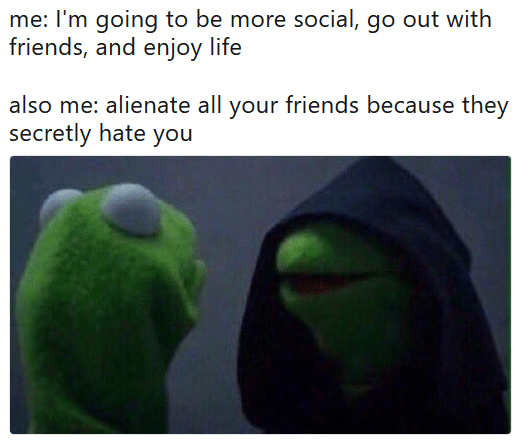Using Therapy to Improve Self-Esteem
Improving self-confidence is a common therapy goal and one of my favorite topics. It touches at the core of who we are and our lovability, worth and capacities. Addressing self-esteem can be a layered issue and typically underlies things like anxiety and depression.
Our self-worth and self-esteem start off high as young kids and most often decrease as we grow up as situations and environments undermine our sense of our worth. And often there are long-held doubts to begin that feel confirmed by those instances. Do you know those negative thoughts that creep in on you when you’re overwhelmed or stressed out? The beliefs that get stuck are ones like “I’m not good enough,” or “something’s wrong with me” or “it’s my fault.”
I call these thoughts the Dark Kermit of our mind (referring to the Kermit the Frog meme of course!). Those messages typically started in childhood from trusted adults and especially impact our self-esteem as well as how much confidence we have in navigating the world. When we have experiences that are shaming, punishing, invalidating, undermining, and so on, we take that feedback in and it can become a story that we attach to ourselves.

Dark Kermit meme
I love helping people see that who they now makes sense when we look at the context of their experiences, especially the early ones. All the feelings, the lack of motivation or fear of failing, body image issues, problems with boundaries, trouble in relationships, etc. all make sense. All of it has a reason and often that reason is about what you didn’t get in the past.
It starts by exploring your story, from the beginning. Who were your parents or caregivers and how did they respond to your feelings as a kid? Was there space for you to be heard? Were they often able to attend to your needs and accept the whole range of your emotions as a child? What stories did you learn about yourself from how they (and/or others) responded to you?
I incorporate parts work based on the psychodynamic work of ego states. This means we look at your current age self (adult or young adult self) as well as your child parts that may be in need of being seen, heard, or cared for. Often as kids, we developed protective parts of ourselves. These parts keep us from feeling distressed by numbing us, helping us avoid or distracting us in some way. They also need to be addressed and come up anytime we try to change.
Often I’ll use EMDR (Eye Movement Desensitization and Reprocessing) in sessions to guide you to notice the somatic body experiences that come up now and trace them back to your younger years to uncover what negative story is happening. In EMDR therapy the impact of the negative experience is cleared through the eight-phase protocol and the story shifts to being one that is more compassionate and strength-based.
By reprocessing the incidents, the negative beliefs just don’t make sense anymore and dissipate. The felt experience also changes, you feel AND believe the healthier belief because you see the bigger picture. We can see that we did the best we could at the time with what we had and notice what wasn’t about us.
You move through feelings of anger, shame, sadness, and grief by noticing the emotions that may not have been able to be expressed at the time. Loving, supportive resources can be woven in so that you learn to provide positive messages and validation.
It’s not magic but sometimes it feels like it because people stuck for years can become unstuck in a matter of a few sessions. The therapy sessions can help integrate previous work done around the issues and help accelerate shifts, healing, and more.
Trying something like EMDR can sound overwhelming and that is 100% okay. Any introspective work is meaningful by itself. By working with me, you will learn to identify negative beliefs, build internal resources and coping strategies as well as recognize the source of current-day issues. Just taking the first step in an act of self-compassion.





0 Comments